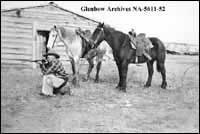The Cowboys
 The typical riders, or "cowboys", of southern Alberta have been characterized as young, rugged, and underpaid. Many young men, often from the ranges of the United States, hoped someday to acquire their own ranches with the money they were paid as riders, but if they were successful it was not on account of the wages. As the records from the Cochrane Ranch indicate, in 1885 the average cowboy earned forty dollars per week, two thirds less than the ranch foreman and even less than either the ranch bookkeeper or cook.
The typical riders, or "cowboys", of southern Alberta have been characterized as young, rugged, and underpaid. Many young men, often from the ranges of the United States, hoped someday to acquire their own ranches with the money they were paid as riders, but if they were successful it was not on account of the wages. As the records from the Cochrane Ranch indicate, in 1885 the average cowboy earned forty dollars per week, two thirds less than the ranch foreman and even less than either the ranch bookkeeper or cook.
And if he was tough, so were his garments. All of a cowboy's clothing and equipment had a specific purpose on the range. He wore heavy wool or flannel underwear to protect him from the cold, a wool shirt in winter and probably a cotton one in the summertime, and sturdy serge or denim pants. His chaps - at first cigar-shaped and then the better fitting "batwing" variety - protected his legs from the brush, rope-burn and other possible scrapes. "Woollies" were chaps covered with angora fur for the winter. A leather vest would have multiple pockets to contain tobacco, matches, a knife and other needful implements. Sometimes he wore a prized buckskin shirt or coat made by Native craftsmen. His hat was essential, as it protected him from the rain, snow, and sun, and a bandana around his neck could be raised to protect his face from dust. The cowboy's boots were made for riding: the toe was pointed so it could fit easily into the stirrup, while the raised heel prevented the foot from slipping through. A six-shooter, or "gun", as the cowboys called it, was not as common or deadly on the Canadian range as is generally believed. If carried at all, a gun was most useful in turning cattle during a stampede or killing predators or injured animals.
 Actually, a cowboy's most essential accessory was his horse. The cowboy was, after all, a rider, there was no other way for him to manage the wild cattle who were frightened by a man on foot, or control a herd of stampeding animals. Two or three horses were generally needed to complete a day's work, as the chores were strenuous and the horses were not bred for endurance. "Bronco-busters" were brave riders who specialized in breaking wild horses for the range.
Actually, a cowboy's most essential accessory was his horse. The cowboy was, after all, a rider, there was no other way for him to manage the wild cattle who were frightened by a man on foot, or control a herd of stampeding animals. Two or three horses were generally needed to complete a day's work, as the chores were strenuous and the horses were not bred for endurance. "Bronco-busters" were brave riders who specialized in breaking wild horses for the range.
 A cowboy's work was seasonal, and when not employed on a drive or round up, he could be expected to perform many different duties related to the ranch and the cattle. Although winter was generally a slow time, and many cowboys took jobs in town, the rider might have to chop holes in the ice of watering holes, or, in later years, provide hay for the animals when snow made grazing impossible. If the winter was particularly severe, stock would drift with the wind, piling up against fences, and a rider would risk frostbite performing missions of search and rescue. In the spring, cowboys would tend to the calving, earmarking the newborns for easy identification. Yet many of a typical cowboy's free days would be spent in town. The warmth and company of a bar or brothel would be a welcome relief from a hard, lonely life on the range.
A cowboy's work was seasonal, and when not employed on a drive or round up, he could be expected to perform many different duties related to the ranch and the cattle. Although winter was generally a slow time, and many cowboys took jobs in town, the rider might have to chop holes in the ice of watering holes, or, in later years, provide hay for the animals when snow made grazing impossible. If the winter was particularly severe, stock would drift with the wind, piling up against fences, and a rider would risk frostbite performing missions of search and rescue. In the spring, cowboys would tend to the calving, earmarking the newborns for easy identification. Yet many of a typical cowboy's free days would be spent in town. The warmth and company of a bar or brothel would be a welcome relief from a hard, lonely life on the range.
the CKUA Heritage Trails:
To listen to the Heritage Trails , you need the RealPlayer, available free from RealNetworks:
- Bar U Ranch: The Life of the Cowboys - Learn about the many types of men on a ranch like the Bar U, from the riders to the choreboys!
Read | Listen - Bar U Ranch: Cowboy Life - Listen to Simon Evans explain living conditions for the riders at the Bar U, and hear about the famous cowboy, Charlie Miller.
Read | Listen - Bar U Ranch: Aboriginal Cowboys - First Nation peoples contributed greatly to the success of the ranches like the Bar U.
Read | Listen
- Legacy Magazine article: Shooting Cowboys
[top] [back] [Farming and Homesteading] [next]









